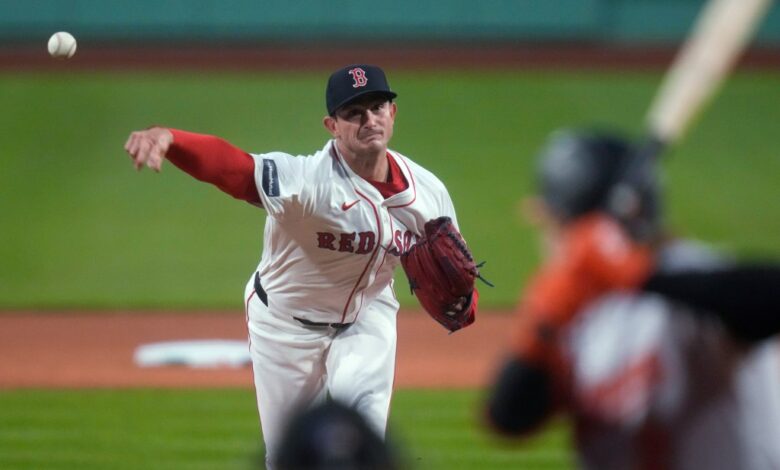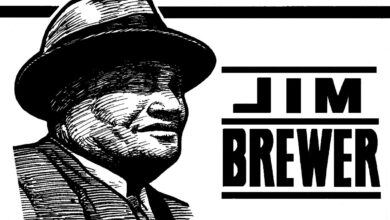Six-man rotation? Shorter bullpen? How should Red Sox manage staff?


The way pitchers get hurt in baseball these days, you can never have too much depth.
Depth has been one of the Red Sox’s biggest problems these past few years. Whenever injuries inevitably crop up, the club hasn’t had enough backup to stay afloat, and the result has been the same each of the past three years — a slow second-half fade.
Now, the Red Sox arguably have the opposite problem.
With the caveat that injuries happen and things could change, the Red Sox have six healthy big league starting pitchers at their disposal, giving them a level of depth matched by few other clubs. The combination of Garrett Crochet, Tanner Houck, Walker Buehler, Brayan Bello, Lucas Giolito and Kutter Crawford could rank among the best in baseball, but the issue is most rotations typically consist of five pitchers, and it’s difficult to imagine a scenario where any of the six move to the bullpen or wind up in Triple-A.
That means the Red Sox are going to have to get creative when it comes to managing their pitching staff.
The most straightforward solution would be to utilize a six-man rotation, but doing so comes with some drawbacks. The six-man setup gives starters more rest between outings, which could be good for guys who are coming off injury or who don’t have experience throwing 180-plus innings, but starters crave a consistent routine and many prefer going every five days.
Having six starters also inherently means one fewer traditional reliever is available in the bullpen, since one roster spot is being taken up by the sixth starter.
Pitching coach Andrew Bailey said he’s open to using a six-man rotation, but ultimately they’ll adapt to whoever is available at any given moment. The club could also adopt a piggyback approach where two starters always go back-to-back on the same day, he said, but no matter what route the club takes, having the depth to find solutions is a welcome change.
“Obviously we’ll continue to have those conversations as we start to get guys back into the rotation and see where we are at the end of spring training, but to have that (six-man) option is good for us,” Bailey said. “We know there’s 162 games to play and we need 162 starters, so however we can manage that, all cards are on the table.”
As far as dealing with a shorter bullpen, Bailey pointed to a couple of solutions that could help the club succeed. One is by leaning on its wealth of young relievers who can be optioned back and forth from Triple-A. As of now at least a half dozen arms who were significant contributors to last year’s bullpen could be on the outside looking in, and being able to cycle through those relievers would enable the Red Sox to always have at least one fresh arm available.
“I don’t want to get ahead of myself but we’ll hopefully have a lot of guys that can kind of come up and down and fill those holes, and always having a guy fresh down there to take on multiple innings is really big,” Bailey said. “It’s always advantageous to make sure you have a guy down there that can give you the 40-60 pitches you need in case things go sideways.”
Another solution is having relievers available who can go multiple innings, and not just the traditional “bulk guy” who typically handles mop-up duty when the team is either well behind or way ahead.
Last year rookie Justin Slaten enjoyed immediate success as a multi-inning weapon, and this year the expectation is Garrett Whitlock will as well.
“He’s a guy that you can hand the ball off and he can go a couple of innings late in the game and give the back end guys a rest, he’s a multi-inning force back there,” Bailey said of Whitlock. “He gives us another way to finish games, not just your typical multi-inning guy just cleaning up some down games or up big games. He’s a guy that can throw multiple innings in close games as well, which gives AC (Alex Cora) a different way to finish ballgames, which is really valuable to us.”
However the pieces come together, having a few too many will be a nice change of pace for the Red Sox after years of not having enough.
Story weighs in on Arenado
Over the past few weeks, one of the most commonly discussed storylines surrounding the MLB offseason has been whether or not the St. Louis Cardinals will trade third baseman Nolan Arenado. The 10-time Gold Glove winner is expected to be moved in order to help facilitate the club’s upcoming rebuild, and lately there have been persistent rumors that Arenado could wind up in Boston.
Though the 33-year-old’s offensive performance has declined in recent years, Arenado is still exactly the kind of right-handed pull hitter the Red Sox are looking for and remains one of the best defensive players in the game. The problem is the Red Sox already have Rafael Devers ensconced at third base, so accommodating both would be a challenge roster-wise.
One person who is uniquely qualified to weigh in on Arenado, however, is Trevor Story. The two played five seasons together with the Colorado Rockies and remain close.
Asked for his thoughts about the prospect of the Red Sox acquiring Arenado, Story offered a nuanced perspective.
“Everyone knows that we’re pretty close, he’s one of my good friends, and this is a unique opportunity. We talk about baseball a lot, I’ll keep those conversations between us but we do have a really good third baseman in Raffy Devers,” Story said. “That’ll obviously be up to someone else to figure out how it works, that’s not my job to talk about that, but obviously just the chance of that happening is exciting for everyone. I’ve played around him a lot and he’s as good as it gets. The intensity that he brings to a team is really beneficial and I think he would thrive at Fenway.”
Story said that when the two were teammates Arenado always set the tone in the infield, and that his approach helped mold Story into the player he is today. Story has since brought that approach with him to Boston, one that he’s now trying to impart on his younger teammates as they look to help turn the club’s infield defense around.
He also said there’s no doubt in his mind Arenado can still be a difference-maker offensively even though his overall production was roughly league average last season, and that playing at Fenway Park could be just what the doctor ordered.
“He’s had a lot of success at Fenway. He’s told me he loves coming through there and feeling the energy. Any right-hander that pulls the ball in the air is a great profile for Fenway and that’s what he does with the best of them,” Story said. “It’s as simple as that, there’s not much in depth stuff to talk about, but he hits the ball hard in the air and plays well at Fenway.”
Realistically, if the Red Sox were to acquire Arenado they would either have to move Devers off third base and open up a spot at another position, or they would have to move Arenado to second base, which wouldn’t make sense given Devers’ comparative lack of defensive ability.
Story said it’s not his job to figure stuff like that out and doesn’t want to comment on the logistics, but he made a point to emphasize that for him, it’s not an issue of choosing between Devers and Arenado. For him, it’s simply about making the team better and bringing in as many talented players as possible.
“Raffy’s the face, man. He’s our best player. I think it’s as simple as we always want good players,” Story said. “Nolan’s made it known that Boston’s a place he’d love to be, but it’s not any of the players here sitting here saying we’d rather have this guy or we’d rather have that guy. Raffy’s the guy, this is his team, it will always be his team. That’s something to make clear, but like I said, when a Hall of Fame player is reaching out wanting to be on your team, that’s something you have to entertain.”
Pedroia likely to remain on ballot
Dustin Pedroia isn’t going to make the Hall of Fame this year, but the way things are trending the longtime Red Sox great should at least garner enough support to prolong his candidacy.
As of this writing Pedroia has appeared on 15 publicly revealed ballots, according to Ryan Thibodaux’s Hall of Fame ballot tracker. That’s just shy of the 20 votes he should need to clear the 5% threshold to remain on the ballot, and with only about 32% of the total vote known, he’ll probably clear that total with room to spare.
Should that happen, Pedroia will clear a crucial milestone in his journey to Cooperstown.
Pedroia’s Hall of Fame candidacy is complicated. On one hand, he was one of the best and most impactful players in baseball for a full decade. Between 2007-16 he was a four-time All-Star, a four-time Gold Glove winner, won Rookie of the Year and American League MVP, and led the Red Sox to two World Series championships. His 51.9 wins above replacement ranks 19th all-time among players who played 75% of their games at second base, and during his 10-year peak he averaged 5.1 WAR per season, which equates to All-Star level production over an entire decade.
On the other hand, Pedroia’s career was basically over by the time he was 33. Chronic knee injuries limited him to only nine games over his last two seasons, preventing him from amassing the counting stats that usually serve as Hall of Fame benchmarks.
MLB notes: Red Sox great Dustin Pedroia faces long Hall of Fame odds
Which should carry more weight? His massive peak or his lack of longevity? That’s a discussion voters could spend years hashing out, but the good news for Pedroia is there are plenty of players who have started with around 10% of the vote who eventually earned induction.
The first and most important step for each of those guys was surviving the first vote. Pedroia may still face long Hall of Fame odds, but at least now it looks likely his candidacy will get the attention it deserves.
Oberg’s new chapter
Though his playing career was cut short due to injuries, former Tewksbury High great Scott Oberg will get another chance to stay involved in the game.
Oberg, who enjoyed a successful five-season run in the majors with the Colorado Rockies, will remain with the organization as a minor league pitching coordinator, according to Patrick Saunders of The Denver Post. The 34-year-old had previously served as a part-time consultant with the Rockies’ minor league affiliates, along with a variety of other unofficial roles after it became clear he wouldn’t be able to pitch again.
Originally a 15th-round pick out of UConn in 2012, Oberg reached the majors in 2015 and posted a 3.85 career ERA in 259 appearances between 2015-19. He closed out Colorado’s 13-inning 2018 Wild Card game victory over the Chicago Cubs, and after the 2019 season he signed a three-year, $13 million contract.
Unfortunately, due to recurring blood clots, the 2019 season wound up being Oberg’s last. He underwent multiple surgeries to correct the problem but never made it back on the mound. He announced his retirement in 2023 after his contract expired, and now he’ll have an opportunity for a new beginning as a coach.
https://www.bostonherald.com/wp-content/uploads/2024/04/Sox.jpg?w=1024&h=683
2025-01-12 05:00:25




